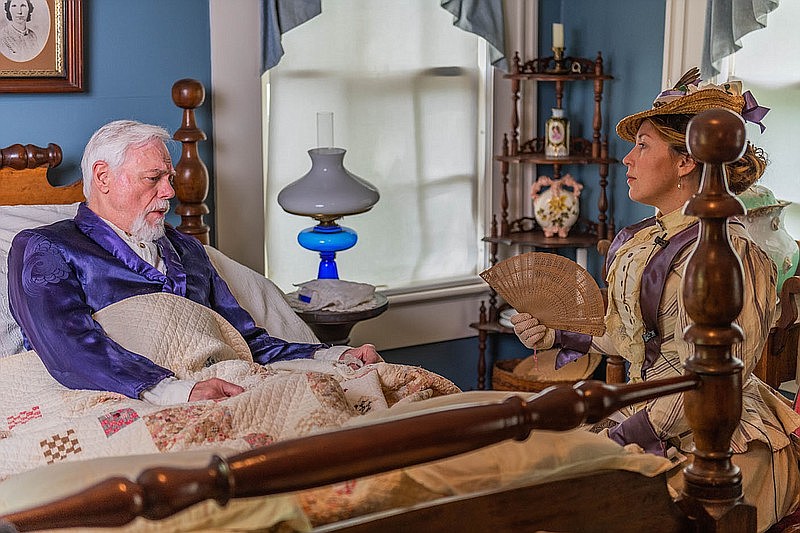At 7 p.m. Wednesday, Arkansas PBS will broadcast Larry Foley's 2020 documentary "Indians, Outlaws, Marshals and the Hangin' Judge."
Foley, a professor and chairman of the School of Journalism and Strategic Media at the University of Arkansas, took an interesting approach with the film. A large part of it is a reconstructed interview that took place between 29-year-old Ada Patterson, a reporter for the St. Louis Republican, and Judge Isaac Parker, the so-called "hangin' judge" who sentenced 160 people to death (79 were actually executed) in the 21 years he served as federal judge for the Federal Court of the Western District of Arkansas, which during his reign had jurisdiction over all of Indian Territory -- more than 74,000 square miles.
Patterson (played by Jennica Schwartzman, who went on to star in the 2022 Hallmark Holiday film "The Christmas Challenge") interviewed Parker (Bill Rogers) in September 1896, shortly after the Indian territories to the west of Fort Smith were removed from Parker's jurisdiction.
Both Patterson and Parker were celebrated figures at the time. Patterson was sometimes referred to as the "Nellie Bly of the West," a reference to the pioneering investigative reporter for the New York World who, in 1889, bettered the fictional protagonist of Jules Verne's "Around the World in Eighty Days" by circumnavigating the globe in just over 72 days.
The 58-year-old Parker was suffering from Bright's disease at the time -- he would die on Nov. 17, 1896 -- and Patterson interviewed him at his bedside. So the meeting was the 19th-century equivalent of a Barbara Walters special, a dramatic summit of two famous people. And Patterson wrote copiously about the meeting in her florid yet easily apprehended style.
Foley -- who won an Mid-America Emmy for directing the film -- ingeniously uses Patterson's reporting as the basis for the core conversation between the bedside reporter and the dying judge. The result is more effective than one might expect.
While a fictional show like Netflix's "The Crown" invents dialogue for characters who bear the names of historical figures, the question of re-enactment in documentaries (much less making up conversations between real people) is controversial. A filmmaker like Robert Greene regularly blurs the line between documentary and fiction in movies like 2016's "Kate Plays Christine" and 2014's "Actress." Others who see themselves more as journalists than artists eschew them entirely.
I agree with Errol Morris, the director of, among others,"The Thin Blue Line," who has written: "Critics argue that the use of re-enactments suggest a callous disregard on the part of a filmmaker for what is true. I don't agree. Some re-enactments serve the truth, others subvert it. There is no mode of expression, no technique of production that will instantly produce truth or falsehood."
Foley's use of Patterson's words works even though the 19th-century prose will sound stilted to some because it has the authority of a primary source. His use of trained actors to play the characters -- as opposed to re-enactors to stand proxy for them -- is a nuanced choice that elevates the film by drawing us deeper into the emotional interiority of the characters.
While we cannot know if Parker smiled at a particular point in the interview, or whether Patterson batted her eyes at the judge to encourage him to go on, we do know they were human beings.
The dialogue is essentially as Patterson reported -- at one point Rogers as Parker says he "does not believe in" capital punishment when Patterson quoted him as saying he did not "favor" capital punishment -- but otherwise the script seems absolutely faithful to the source. And some of Patterson's prose is delivered in voice-over, as she tells the story of how she also visited with "The Prince of Hangmen," Parker's executioner George Maledon.
This central Patterson-Parker interview is supplemented by more traditional talking-head interviews with experts including UA law professor Stacy Leeds, a citizen of the Cherokee Nation; historians Charles Robinson and Elliott West of UA; and Tom Wing and Daniel Maher of the University of Arkansas at Fort Smith.
Shot on location in Fort Smith, "Indians, Outlaws, Marshals and the Hangin' Judge" is a lively (though at times appropriately sober) look at crime, punishment, Indian displacement, and the complex legacy of an infamous judge.
Email: pmartin@adgnewsroom.com
87 Cast: Jennica Schwartzman, Bill Rogers, John Hagen, Steven Marzolf, Michelle Hunter, Reginald Moore, Roger Carter, Eddie Ward,. Harold Trisler, Floyd Robison
Director: Larry Foley
Rating: TV-MA
Running time: 1 hour, 20 minutes
Airing on Arkansas PBS at 7 p.m. Wednesday, with repeats to follow.
